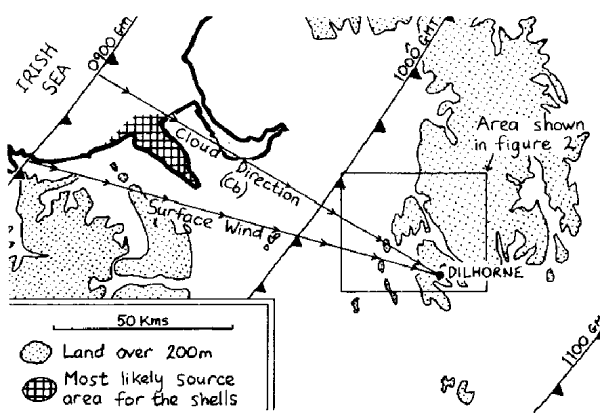 |
Science Frontiers ONLINE No. 31: Jan-Feb 1984 |
|
|
Three Anomalies In One Storm
"During the passage of a cold frontal trough between 1030 and 1100 GMT on Monday 21 March 1983, squally thunderstorms affected south Cheshire and north Staffordshire. Two incidents of ball lightning, a fall of seashells and three occurrences of probable tornado damage were reported, mostly within a 10 km radius of Stoke-on-Kent."
At Camillus Road, Knutton. Ball lightning about 40 cm in diameter with a luminous tail 4 m long. One observer saw it descend at an angle of 45� and hit the roadway.
At Kingsley:
"A large white luminous ball, probably over a metre in diameter, blasted its way into a factory workshop by shearing an irregular hole through a steel-mesh-reinforced window. There was no evidence of any fusion of the glass. The ball, accompanied by a deafening roar, passed very quickly in a straight line through the processing shop and left by blasting a 2 by 3 metre hole in a wall of 6 mm corrugated asbestos, fragments of which were later found 20 to 30 metres away outside the factory."
At Dilhorne. Sea shells fell with heavy hail:
"They extended for an area of about 50 by 20 metres and occurred in thousands on lawns, flower beds, paths and even the road. Roy was kind enough to give me half-a-dozen specimens for identification. They turned out to be small gastropods, almost certainly of marine origin."
Recourse to field guides did not result in positive identification, so samples were sent to the Bristol Museum. The specimens turned out to be Dove Shells, family Columbellidae, genus Pyrene, which are normally inhabitants of the tropical seas. Their most likely origin was the Philippines!
(Swinhoe, P.J.; "Unusual Events along the Squally Cold Front of 2l March 1983 in North Staffordshire," Journal of Meteorology, U.K., 8:233, 1983.)
 | Probably track of the shell-carrying vortex. The actual shells, however, are not typical of the Irish Sea! In addition, the Irish Sea was a considerable distance away! |